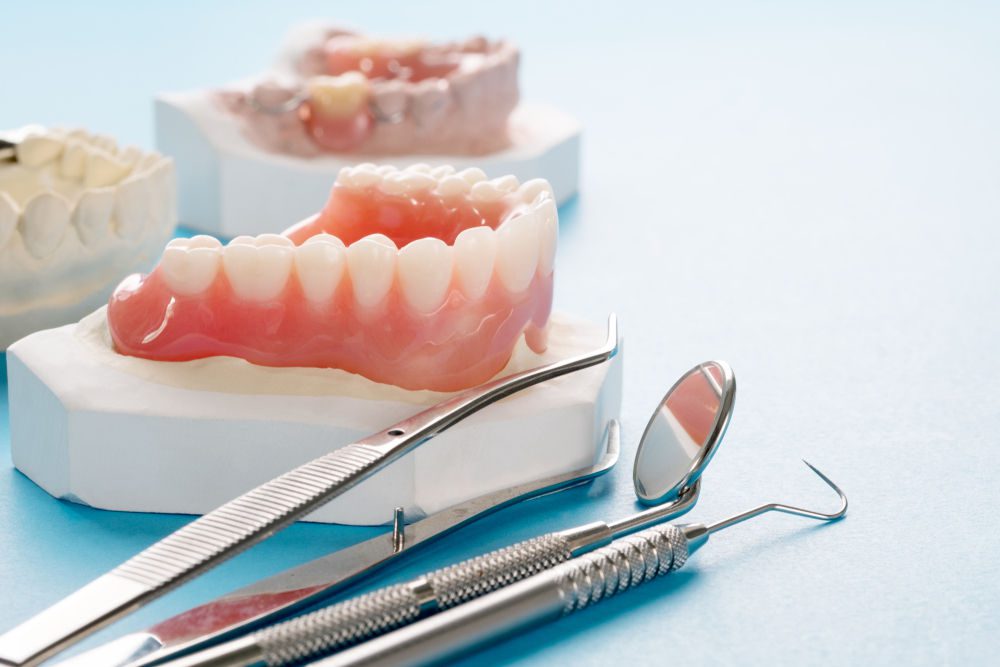Dentures
Complete dentures can be either “conventional” or “immediate.” Made after the teeth have been removed and the gum tissue has begun to heal, a conventional denture is ready for placement in the mouth about eight to 12 weeks after the teeth have been removed.
Unlike conventional dentures, immediate dentures are made in advance and can be positioned as soon as the teeth are removed. As a result, the wearer does not have to be without teeth during the healing period. However, bones and gums shrink over time, especially during the healing period following tooth removal. Therefore a disadvantage of immediate dentures compared with conventional dentures is that they require more adjustments to fit properly during the healing process and generally should only be considered a temporary solution until conventional dentures can be made.
Yes, dental implants can be used to support cemented bridges, eliminating the need for a denture. The cost is usually greater, but the implants and bridges more closely resemble the feel of real teeth. Dental implants are becoming the alternative to dentures but not everyone is a candidate for implants.
Dental implants may also be used to support dentures, offering more stability.
Consult your dentist for advice about implants
The denture development process takes a few weeks and several appointments. Once your dentist or prosthodontist (a dentist who specializes in the restoration and replacement of teeth) determines what type of appliance is best for you, the general steps are to:
- Make a series of impressions of your jaw and take measurements of how your jaws relate to one another and how much space is between them.
- Create models, wax forms, and/or plastic patterns in the exact shape and position of the denture to be made. You will “try in” this model several times and the denture will be assessed for color, shape, and fit before the final denture is cast.
- Cast a final denture.
- Adjustments will be made as necessary
New dentures may feel a little odd or loose for a few weeks until the muscles of the cheeks and tongue learn to keep them in place and you get comfortable inserting and removing them. Also, it is not unusual for minor irritation or soreness to occur and for saliva flow to increase when you first start wearing dentures, but these problems will diminish as the mouth adjusts.
New dentures may feel a little odd or loose for a few weeks until the muscles of the cheeks and tongue learn to keep them in place and you get comfortable inserting and removing them. Also, it is not unusual for minor irritation or soreness to occur and for saliva flow to increase when you first start wearing dentures, but these problems will diminish as the mouth adjusts.
After getting dentures, you may have difficulty pronouncing certain words. If so, practice by saying the difficult words out loud. With practice and with time you will become accustomed to speaking properly with dentures.
If dentures “click” while you’re talking, contact your dentist. Dentures may occasionally slip when you laugh, cough, or smile. Reposition the dentures by gently biting down and swallowing. If any speaking problem persists, consult your dentist or prosthodontist.
Your dentist or prosthodontist will instruct you as to how long to wear dentures and when to remove them. During the first several days after receiving your denture, you may be asked to wear it all the time, including while you sleep. Although this may be temporarily uncomfortable, it is the quickest way to identify the areas on the denture that may need adjustment. Once adjustments are made, you should remove dentures before going to bed. This allows gum tissues to rest and allows normal stimulation and cleansing by the tongue and saliva. The denture can be put back in the mouth in the morning.
A denture adhesive may be considered under the following circumstances:
- To enhance satisfaction with a properly constructed denture. Adhesives enhance retention, stability, bite force, and an individual’s sense of security.
- To assist individuals with dry mouth conditions that lessen denture adherence, such as individuals taking cold medications, those with neurological disabilities including strokes, and the elderly
- To provide added stability and security for those who place unusual demands on facial muscles, such as public speakers or musicians.de, you should remove dentures before going to bed. This allows gum tissues to rest and allows normal stimulation and cleansing by the tongue and saliva. The denture can be put back in the mouth in the morning.
There are situations when denture adhesives should not be used. Those cases include:
- When it is used as a “fix” for ill-fitting or poorly constructed dentures. If dentures begin to feel loose, cause discomfort or cause sores to develop, contact your dentist as soon as possible.
- When a dentist has not evaluated dentures for a long time. Dentures rest on gum tissue and the jawbone, which shrink and deteriorate, respectively, over time. Therefore, the real problem might be a need for a denture adjustment or new dentures.
When oral hygiene practices cannot be sustained. - When adhesives have been used for a long time, especially when visits to the dentist are infrequent, and when the frequency and volume of the adhesive use increases. These developments may indicate the need for a denture adjustment or new dentures.
- When any known allergy exists to the adhesive’s ingredients
Here are some tips to consider when applying denture adhesives:
- Use the minimum amount necessary to provide the maximum benefit. Apply less than you think you need, and then gradually increase the amount until you feel comfortable.
- Distribute the adhesive evenly on the tissue bearing surface of the denture.
- Apply or reapply when necessary to provide the desired effect.
Always apply the adhesive to a thoroughly clean denture. - Remember adhesives work best with a well-fitting denture.
- Paste application. Apply this denture adhesive to a dry or preferably wet denture. Avoid placing adhesive close to the denture borders. If the adhesive oozes, use less of the product. For dentures on the upper jaw, apply three short strips of adhesive — or a series of small dots — along the ridge area and one down the center. For dentures on the lower jaw, apply three short strips of adhesive — or a series of small dots — in the center of the ridge area.
- Powder application. Sprinkle a thin, uniform layer throughout the tissue-bearing surface of the denture. Shake off excess powder and press the denture into place. Powders may be preferred over pastes because they are easier to clean off the denture and tissue. In addition, they don’t have the same tendency as pastes do to “shim” (keep the denture away from the tissue).
Proper denture care is important for both the health of your dentures and your mouth. Here are some tips:
- Handle dentures with great care. To avoid dropping them, stand over a folded towel or a full sink of water when handling them.
- Brush and rinse dentures daily, but not with toothpaste. Toothpaste is abrasive and makes microscopic scratches where food and plaque can build up. Like natural teeth, dentures must be brushed daily to remove food and plaque. Brushing also helps prevent permanent stains on the dentures. Use a brush with soft bristles that is designed for cleaning dentures. Avoid using a hard-bristled brush, as it can damage or wear down dentures. Gently brush all surfaces of the denture, and be careful not to damage the plastic or bend attachments. In between brushings, rinse dentures after every meal.
- Clean with a denture cleaner. You can use hand soap or mild dishwashing liquid for cleaning dentures. Household cleansers and many toothpastes may be too abrasive for dentures. Also, avoid using bleach, as this may whiten the pink portion of the denture. Or you can try an ultrasonic cleaner. This is a small bathtub-like device that contains a cleaning solution. You put the denture in the tub, and sound waves create a wave motion that dislodges the deposits. An ultrasonic cleaner does not replace a thorough daily brushing. Products with the Canadian Dental Association (CDA) Seal of Acceptance are recommended because they have been evaluated for safety and effectiveness.
- Take proper care of dentures when not wearing them. Dentures need to be kept moist so they don’t dry out or lose their shape. When you’re not wearing them, put dentures in a denture cleanser soaking solution or in water. But if the denture has metal attachments, the attachments could tarnish in a soaking solution. Your dentist can recommend the best methods for caring for your dentures. Never put dentures in hot water, which can make them warp.
Even with full dentures, it is important to brush your gums, tongue, and palate with a soft-bristled brush every morning before putting the dentures in. This removes plaque and boosts circulation in the mouth. Pay special attention to cleaning teeth that fit under the denture’s metal clasps. Plaque that gets trapped under the clasps will raise the risk of tooth decay. If you wear a partial denture, be sure to remove it before brushing your natural teeth. Clean, rest, and massage your gums regularly. Rinsing your mouth daily with lukewarm saltwater will help clean the gums. Eat a balanced diet to maintain proper nutrition and a healthy mouth.








